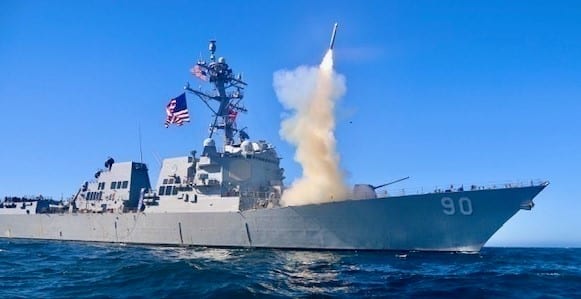
DAHLGREN. Va. — Scientists and engineers at Naval Surface Warfare Center Dahlgren Division (NSWCDD) are developing and delivering upgrades to the Navy’s Vertical Launch Systems (VLS), improving the fleet’s anti-air, ship self-defense, ballistic-missile defense and land-attack capabilities despite the COVID-19 pandemic, the NSWCDD said in an April 23 release.
What’s more, NSWCDD hired new software and test engineers to support the continuous increase in VLS upgrades since the command’s maximum telework policy took effect in March 2020.
“As the Vertical Launch System grows into other platforms, it has created more work opportunities in our branch,” said Felix Lopez, NSWCDD Maritime Weapons & Launcher Systems Integration branch head. “As a result, we knew we had to grow the team.”
New work opportunities within the branch include supporting capability upgrades as well as the continued authorization and certification of the Mk41 and Mk57 VLS for shipboard test events and tactical operations.
Lisa Haas, an NSWCDD engineer and the acting certification official for MK 41 and MK 57 VLS, said she has never seen the branch and its VLS programs busier in her 31 years at NSWCDD.
“Over the last three years, we have had more changes going into our programs, more capability upgrades than we have ever had, and it’s impacting more pieces of our system than ever,” said Haas.
The Mk41 is a highly adaptable canister launching system capable of dispatching missiles for every threat in naval warfare. The system’s adaptability enables myriad upgrades, earning its place as one of the fleet’s most significant defense capabilities.
These upgrades keep NSWCDD — the sole Certification Agent and Technical Direction Agent — busy.
Some recent projects included upgrades to Mk41 to support the launch of Standard Missile, Evolved Sea Sparrow Missile and Tomahawk Missile variants. The recent upgrades in support of the Tomahawk Weapon System were so comprehensive that every ship in the U.S. Navy equipped with the Mk41 VLS is a candidate to receive the Tomahawk capability upgrades.
To keep up with these sweeping changes that affect such a large part of the fleet, Lopez said the team was due for a hiring effort when he came aboard as branch head in 2019.
“We had an issue with increasing tasking while our staffing remained about the same. This triggered hiring left and right,” said Lopez, who brought on several software and test engineers in the last year. “It’s been a challenge, but we’re doing quite well. Every time you get new personnel, you have to train them. The subject matter experts have to continue doing their job, but they also have to allocate time to train new personnel and they’ve been very effective at that.”
Haas, one such VLS expert on the team, said the pandemic-driven telework presented challenging but navigable obstacles in training the new recruits.
“It’s been more challenging to train new folks because they can’t be embedded in the middle of our large technical group with all the knowledge right there for them,” said Haas. “But we can get them approved to be on base a little more often so that we can directly interface with them. It’s very important to get new folks [on base] so that they can begin to feel part of the team and get that sense of loyalty that you get when you work with a team and a sense of pride in what you’re doing.”
This sense of pride that comes along with working in VLS is apparent in talking to Haas and Lopez. Both reference the spirited atmosphere surrounding the team and are quick to praise both the new recruits and the seasoned professionals that have been working with VLS at Dahlgren for years.
“A lot of folks in our group have been around a long time – they are very knowledgeable, capable and proactive,” said Haas. “They know what the job is and they get it done.”
When getting the job done means supporting a substantial percentage of our warfighters’ naval defense capability, it takes a dedicated and multidisciplinary team of experts. From software engineers and computer scientists to mechanical engineers and safety professionals, the team at NSWCDD continues to support the fleet’s capabilities while collaborating effectively to meet the needs of the U.S. Navy.
“VLS works together as a team very well,” said Haas after rifling off more than a handful of names of teammates and partners that led to the branch’s success in the last three years. “It’s absolutely amazing the engineering that goes into the system, how it all works together and works together rather well. It’s impressive.”
- VMUT-2 begins assembly of the first 2nd MAW MQ-9A Reaper - April 18, 2024
- CORAS Rolls Out Early Release of Driver Trees Tool - April 18, 2024
- VMM-268 Marines Prepare for Marine Rotational Force Darwin - April 18, 2024






